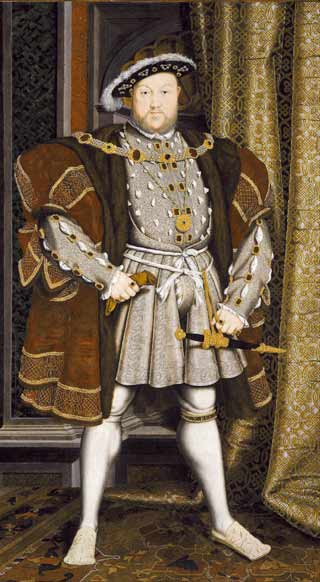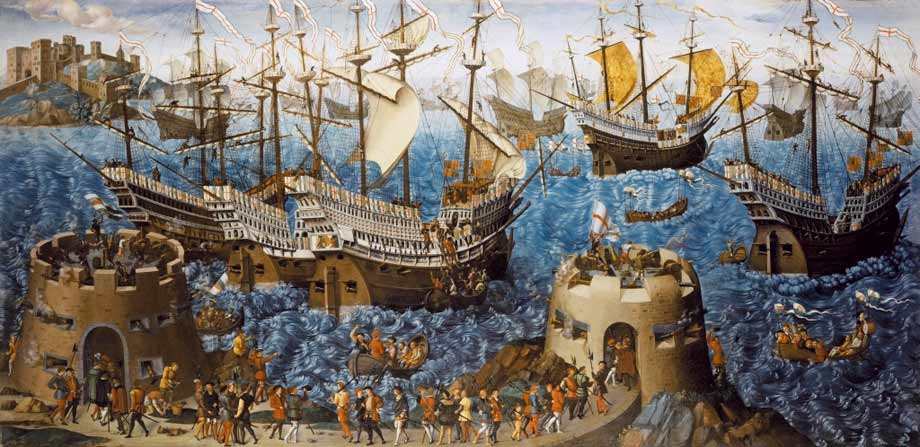|
|
 to Elizabeth Taylor
‘For she’s not froward , but modest as the dove’
Once upon a time, according to Charles Perrault and his Contes du Temps (1697) there was a murderous tyrant called Bluebeard who went on a journey leaving his new wife the keys of his castle, but forbidding her to enter one room. Henry VIII, second son of Henry VII began his reign April 22, 1509 being nearly 18 years of age. He was a comely prince but grew too corpulent in the latter part of his life. He was skilful in all bodily exercices, brave without ostentation, of a frank and candid disposition and liberal to excess. Henry loved study and such sciences that are seldom acquired by mighty Princes. He was perfectly well versed in music (some compositions of his being still extant) and skilled both in Philosophy and Divinity. On the other hand, he was cruel and withal very presumptuous, which caused him often to be overreached by those Princes who had any contest with him.
He was a great stickler for the See of Rome ; nobody could have shown more zeal for it than he did in the beginning of his reign. He even wrote against Luther a Latin book concerning the Seven Sacraments and this gained him the title of Defender of the Faith which Pope Leo X bestowed upon him by a Bull, anno 1521 and the King’s Book still refers to HenryVIII’s Necessary Doctrine and Evolution for any Christian Man (1543). Zealous even in his orthodoxy, he was dutiful in the roasting of heretics. He employed bishops as counsellors of State, culminating in the grand finale of Cardinal Wolsey (a butcher’s son) who kept a house of nearly a thousand persons and obtained for his natural son 4 archdeaconries, a deanery, 5 prebends and 2 rectories ; all this found its popular ex But Henry was not always actuated with the same zeal for the Holy See ; for that court having refused to give him the wished for satisfaction, with regard to the divorce, he separated himself, together with his subjects, from that church. Henry had first married Katherine of Aragon, relict of his eldest brother but after 18 years cohabitation and his having had 3 children by her (Princess Mary and 2 other children who died young), he resolved to rid himself of the Queen. It is said that Cardinal Wolsey (‘no man’s pie is freed from his ambitious finger’) seeking for an opportunity of revenging himself on Charles V who had promised to get him elected Pope, but had broken his word, caused a proposal to be made to Henry by Longland, his confessor, to divorce Katherine, upon pretence, that the whole world exclaimed against this marriage and that the Pope had exceeded the limits of his power in granting a dispensation.
Henry, being of a fickle temper, was very much tired of being so long married to one woman and relished the proposal made him by Wolsey. He had, by then, fallen passionately in love with Anne Boleyn and he commanded Cardinal Wolsey to intercede with the Pope Clement VII to obtain a divorce from Catherine. The Pope, at first, gave him some hopes which only enflamed Henry the more ; but his scruples to dissolve a marriage of 18 years continuance, concluded by virtue of the dispensation of a former Pope and blessed with 3 children whereof one was still living, or rather the fear of angering so formidable a Prince as Charles V induced the sovereign pontiff to change his former resolutions. Henry employed flattery, entreaties, menaces, money and his credit with Francis I : it was all of no use. Then Henry grew tired, sent Katherine to Kimbolton, one of the royal palaces in Huntingtonshire and privately married Anne, sir Thomas Bullen’s daugher, whom the year before he had created Marchioness of Pembroke, and who was crowned June 1, 1533. Anne Bullen gave Henry one daughter named Elisabeth, who succeeded Queen Mary and was beheaded the 16th of May, 1536, a martyr to Henry’s jealousy. The Lord Rochford, brother to that Queen, was accused of having committed incest with his sister and beheaded together with four of the Queen’s servants who were accused of a criminal correspondance with her. But there is no convincing proof of the justice of this charge and it must be observed that the Roman Cahtolics and Cardinal Wolsey did all that lay in their power to sully her fame because she favoured the Reformation. The very next day, Henry VIII took Jane Seymour to wife and she was crowned with the utmost magnificence. This Queen was delivered (October 12, 1537) of Prince Edward (who succeeded his father) and of whom she died in childbed. His fourth wife was Anne de Cleves, sister to the Duke of Cleves. This lady was represented to Henry as one of the most lovely women of her age ; but he was so much disgusted at the first sight of her, that he could never prevail with himself to love her and put her from him 5 months later : Tastes differ ! Katherine Howard, niece to the Duke of Norfolk and cousin-german to Anne Boleyn was his fifth wife. As she was a great beauty, he fell suddenly in love with her ; but it was not lasting she being accused of adultery. Dereham, Mannock and Colpeper confessing that they had often lain with her, were all three beheaded. The Queen admitted that, before her marriage, she had prostituted herself to several but denied, as she hoped to enter into heaven her having polluted her consort’s bed. She was condemned, in all fairness, by Act of Parliament to lose her head and was executed accordingly upon Tower Hill the 12th of February 1542. His sixth wife was Katherine Parr, relict of Lord Latimer. She was handsome, and her engaging and insinuating carriage gained her universal esteem ; to which it must be added that she had an extensive and penetrating genius. This Lady ambraced the doctrine of Luther, which had like to have cost her life ; but she escaped the King’s cruelty : her caresses and entreaties were so prevalent, that he revoked the order he had given for seizing and bringing her to a trial ; but perhaps she would not have been safe, had not death snatched away King Henry some time after. The King died of a complication of humours falling upon an old sore in his leg on January 28th, 1547, he being 56 years of age.
In truth, the Famous Six, when individually considered, lose a good deal of the fascination that belongs to them as a team ; Anne of Cleves, during most of her long sojourn in England,was just the wealthy and cheerful maiden aunt of the Tudor family ; Jane Seymour was a mere pawn in the dynastic game and, as it proved, a gambit pawn at that ; the main interest of Katherine Parr’s career belongs to the years after Henry’s death ; even a tragic end, bravely confronted, cannot overcome the natural distaste of posterity for the cold and calculating Anne Boleyn – alias Anna Bolena, the opera by Donizetti, oddly enough high in favour with the prima donnas but not with Wolsey, of course :
Only two of the six can still command much sympathy. The patient and dignified endurance of Katherine of Aragon And though Katherine Howard, had she lived, might have sunk to any depth of depravity, her gay and gallant acceptance of the penalty of her youthful wantonness causes her, in fact, to be remembered as the most pitiful example in Enlish history of the breaking of a butterfly on St. Catharine’s wheel.
If wooing is the most exciting of man’s emotional experiences, and if music has always been ‘the food of love’, who will cast the first hymn (be it the Veni Creator !) to Henry VIII the Troubadour who dared side, as Shakespeare puts it, with the ‘sly whoresons’ that |
ADG-Paris © 2005-2024 - Sitemap






